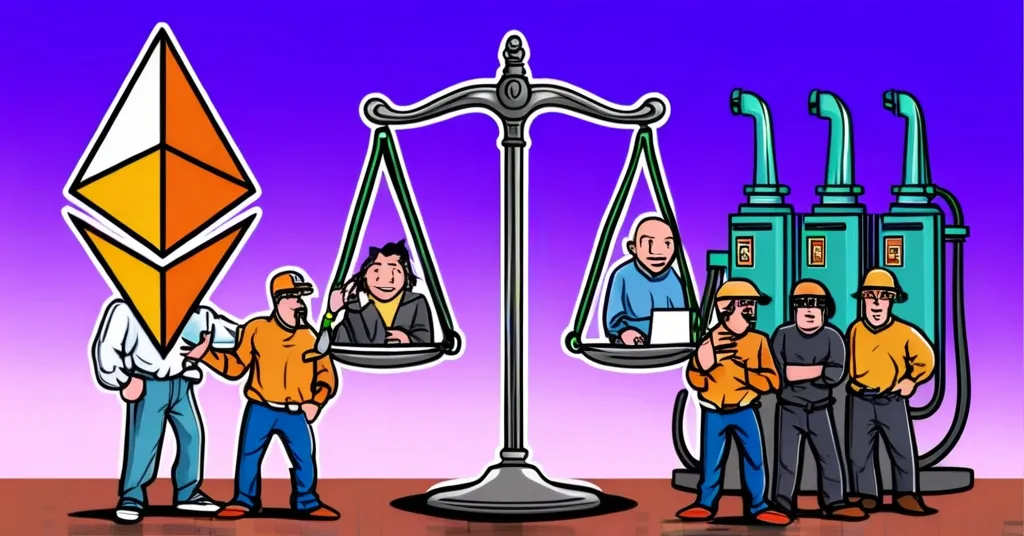Consensys Endorses Ethereum Gas Limit Hike: Scalability Boost or Centralization Risk?

Consensys Backs Ethereum Gas Limit Increase: A Step Forward or a Leap into Centralization?
Consensys, a pivotal force in the Ethereum ecosystem, has endorsed a proposal to elevate the network’s gas limit, aiming to combat the blockchain’s persistent scalability issues. This move, while promising to lower transaction fees and ease network congestion, raises critical questions about the delicate balance between decentralization, security, and the imperative to scale.
- Consensys supports gas limit increase
- Aims to boost Ethereum scalability
- Raises concerns about centralization
- Part of broader Ethereum scalability efforts
As Ethereum grapples with high transaction costs and network bottlenecks, Consensys’s support for increasing the gas limit from its current 30 million to potentially 60 million has ignited a lively debate. The gas limit, essentially the cap on the processing power allowed per block, plays a crucial role in determining the network’s capacity and the cost of transactions. “Increasing the gas limit is a necessary step to ensure Ethereum remains competitive and accessible to users facing high transaction fees,” a Consensys spokesperson emphasized. This adjustment could indeed empower the everyday user, enhancing Ethereum’s appeal for transactions and decentralized applications (DApps).
However, the road to scalability is riddled with complexities. Critics within the Ethereum community warn that increasing the gas limit might favor miners with more robust resources, potentially leading to increased centralization. “While scalability improvements are crucial, we must remain vigilant about the potential risks of centralization and security vulnerabilities,” cautioned a seasoned blockchain expert. A higher gas limit could also make running full nodes—a cornerstone of Ethereum’s decentralized nature—more challenging.
Ethereum’s journey towards scalability has been marked by significant efforts. The London upgrade with EIP-1559, which introduced a new fee structure, and the upcoming Pectra Upgrade, are testament to Ethereum’s commitment to evolve. Yet, the community remains divided on the best approach forward. Even Ethereum co-founder Vitalik Buterin suggests a more cautious 33% increase to a 40 million gas limit, highlighting the ongoing debate within the ecosystem. For more details on the proposal, see Consensys Ethereum gas limit increase proposal details 2023.
Layer-2 solutions like rollups are integral to Ethereum’s scalability strategy. These technologies must be considered alongside any changes to the gas limit. The potential for new types of DApps and increased transaction throughput hints at a promising future for Ethereum, provided these scalability efforts bear fruit.
As Ethereum strives to maintain its leadership in blockchain technology, the proposal backed by Consensys underscores the delicate balancing act of enhancing scalability while safeguarding decentralization and security. It’s a reminder that in the world of cryptocurrencies, the path to progress is often paved with both opportunities and challenges. For a deeper analysis on the risks and benefits, refer to Ethereum gas limit increase risks and benefits analysis.
Key Questions and Takeaways
- What is the goal of raising Ethereum’s gas limit?
The goal is to enhance Ethereum’s scalability by increasing the network’s capacity and reducing transaction fees, making it more accessible for users.
- What are the potential downsides of this increase?
A higher gas limit could lead to increased centralization, as larger blocks may favor miners with more resources, and introduce potential security vulnerabilities due to higher computational demands.
- How does this fit into Ethereum’s broader scalability strategy?
This proposal is one facet of Ethereum’s ongoing efforts to improve efficiency and competitiveness, complementing other initiatives such as Ethereum 2.0. For a comparison with other scalability solutions, see Ethereum scalability solutions comparison Ethereum 2_0 vs gas limit increase.
- What role does Consensys play in shaping Ethereum’s future?
As a leading developer and advocate in the Ethereum ecosystem, Consensys significantly influences Ethereum’s direction through proposals like the gas limit increase. For community discussions on this topic, visit Consensys Ethereum scalability proposal reddit.
- What could this mean for everyday Ethereum users?
Users might experience lower transaction fees and less network congestion, but they should remain aware of the potential trade-offs to decentralization and network security.
- Are there alternative solutions to Ethereum’s scalability problem?
Yes, Layer-2 solutions like rollups are crucial to Ethereum’s scalability strategy and should be considered alongside any changes to the gas limit.
- How does this proposal align with Bitcoin’s principles?
While Bitcoin prioritizes security and decentralization over scalability, Ethereum’s approach reflects a different balance, aiming to cater to a broader range of use cases and possibly sacrificing some decentralization for scalability.
- What is the significance of Vitalik Buterin’s suggestion in this context?
Buterin’s more conservative approach to the gas limit increase showcases the ongoing debate within Ethereum about the right pace and extent of scalability enhancements.
- Could this move impact the growth of decentralized applications (DApps)?
Yes, by improving scalability, Ethereum could become a more attractive platform for DApps, potentially fostering innovation and growth in the sector.
- What are the risks of Ethereum becoming too centralized?
Increased centralization could undermine Ethereum’s core value proposition of being a decentralized platform, potentially leading to vulnerabilities and loss of user trust. For more information on gas limits, see Ethereum gas limit increase wiki.



